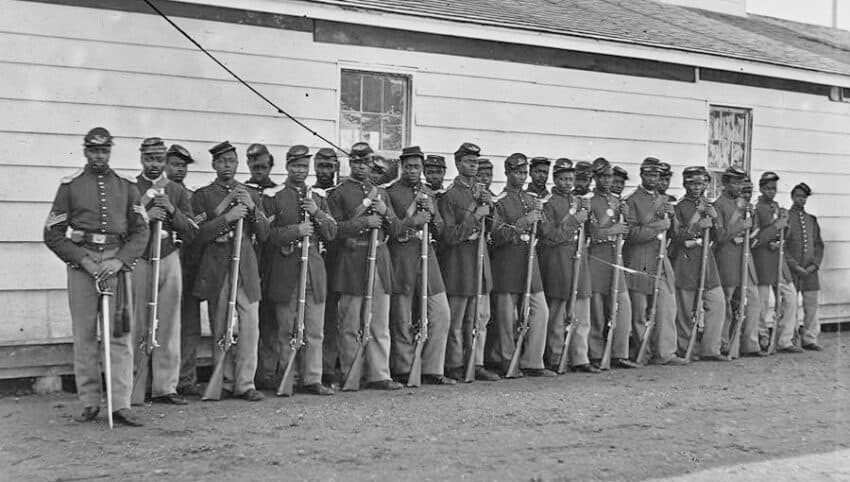
The 54th Massachusetts, the first Black regiment of the Union Army, 1863 Boston. Library of Congress
May 17, 1863 – June 6, 1863
By Phil Kohn
Phil Kohn can be reached at USCW160@yahoo.com
After suffering 3,851 casualties at Champion Hill, northeast of Vicksburg, Mississippi, Lt. Gen. John Pemberton’s Confederates withdraw across the Big Black River on May 17, 1863, burn the bridges behind them and take up defensive positions around Vicksburg. In Louisiana, the Union forces of Maj. Gen. Nathaniel Banks move to a point directly across the Mississippi River from Port Hudson, threatening that vital position.
On May 18, Grant’s troops hastily build bridges and cross the Big Black River. Gen. Joseph Johnston, in overall Confederate command, orders Vicksburg evacuated. Lt. Gen. Pemberton — unsure of how to get out and unwilling to lose the city — opts to stay put with his 30,000 Confederate defenders. In western Virginia, a Confederate force attempts to dislodge Federal troops holding Fayetteville but are unsuccessful.
With Vicksburg, Mississippi, surrounded by 60,000 Federal troops, Maj. Gen. Grant on May 19 launches his first land assault directly against the city. The Union offensive is repelled by the strongly entrenched Confederates. Union casualties number around 1,000.
May 20 sees skirmishing between Union and Confederate forces around Ft. Gibson, in the Cherokee Nation of Indian Territory.
Maj. Gen. Banks on May 21 is busy positioning his 15,000 Union troops around Port Hudson, Louisiana. Farther north, a Federal flotilla advances toward Yazoo City, Mississippi, located on the Yazoo River. Confederates hastily destroy two steamboats and a gunboat at the navy yard there, as well as a number of workshops.
Grant orders another land-based attack on Vicksburg on May 22 that is again turned back. Casualties: U.S., 3,199; C.S., less than 500. Realizing that frontal assaults will not break through to the well-situated, strongly defended city, Grant decides to besiege Vicksburg. The 30,000 Confederate defenders are surrounded by 60,000 Union soldiers on land and numerous Federal gunboats on the Mississippi River.
On May 24, Maj. Gen. John Schofield replaces Maj. Gen. Samuel Curtis as commandant of the Federal Department of the Missouri, in charge of some 25,000 troops.
At Vicksburg, Mississippi, on May 25, Union troops, having dug a tunnel under Confederate lines and packed it with 2,200 pounds of black powder, set off the explosives. The idea is to open an access route into the city. It doesn’t work. Says Maj. Gen. Grant afterward: “The effect was to blow the top of the hill off and make a crater where it had stood. The breach, however, was not sufficient to enable us to pass a column through. In fact, the enemy had thrown up a [defensive] line further back.” In the South Atlantic Ocean, CSS Alabama seizes another two U.S.-flagged vessels off the coast of Bahia, Brazil. Peace Democrat Clement Vallandigham — arrested, charged with and convicted by a military court for publicly “expressing sympathy for those in arms against the Government of the United States” — is released from prison on May 25 and forced to enter Confederate lines in Tennessee. President Lincoln — wary of making Vallandigham a martyr to the Copperhead [anti-war] cause — has changed his punishment from being jailed to being banished from the United States. The episode provokes widespread outrage in the North and inspires Massachusetts author, historian and Unitarian minister Edward Everett Hale to write his classic short story “The Man Without a Country” that is published in The Atlantic Monthly magazine.
Having positioned his men around Port Hudson, Louisiana, Maj. Gen. Nathaniel Banks on May 27 orders an assault on the Confederate positions. Some 13,000 Union soldiers, including the 1st and 2nd Louisiana Colored Regiments, charge but are repelled by 4,500 entrenched Confederate defenders. Union losses number 293 killed, 1,545 wounded and 157 missing. The Confederates tally their casualties at around 235.
On May 28, the 54th Massachusetts Infantry Regiment — the second African American regiment organized by the Union Army (the first was the 1st Kansas Colored Volunteer Infantry Regiment, organized 6-1/2 months earlier than the 54th Massachusetts, in August 1862) — departs Boston to begin training at Hilton Head, South Carolina.
In Washington, D.C., President Lincoln on May 29 receives a letter from Maj. Gen. Ambrose Burnside, offering his resignation as commander of the Department of the Ohio. The reason: The release of Ohio politician Clement Vallandigham (it was Burnside that ordered his arrest) and the president’s action rescinding Burnside’s order for Vallandigham’s imprisonment. Lincoln refuses to accept Burnside’s resignation.
On May 30, Robert E. Lee, dealing with the loss of Lt. Gen. Thomas “Stonewall” Jackson, reorganizes the Army of Northern Virginia into three corps, headed by Lt. Gens. James Longstreet, A.P. Hill and Richard Ewell.
In the Federal Department of the Ohio, public outrage continues to swell over actions taken by the department’s commandant, Maj. Gen. Ambrose Burnside. This is especially true in Chicago, Illinois, where Burnside continues to press for the suppression of the Chicago Times newspaper for “repeated expressions of disloyalty and incendiary statements.” Burnside had already halted publication of the periodical for nine days in February. On June 1, 1863, Chicago mayor Francis C. Sherman appeals to President Lincoln directly to “strike down” Burnside’s repressive orders.
From Washington, D.C., President Lincoln wires Maj. Gen. Grant, asking him if he is “in communication with General Banks?” Military advisors in the Federal capital feel the two should combine their forces. However, Grant, near Vicksburg, Mississippi, and Banks, near Port Hudson, Louisiana, determine to continue operations separately.
On June 3, elements of Robert E. Lee’s Army of Northern Virginia begin heading northwest from the Fredericksburg, Virginia, area, initiating the invasion of Pennsylvania. In South Carolina, Col. Robert Shaw and his 54th Massachusetts Regiment arrive at Port Royal.
At Vicksburg, Mississippi, on June 4 Confederate military and civilians start preparing to weather the siege being established around their city by Union forces.
Severe fighting on June 5 at Fredericksburg, Virginia, between Confederates under Maj. Gen. A.P. Hill (left behind by Lee on his move northward) and Union troops of the Army of the Potomac’s VI Corps under Maj. Gen. John Sedgwick indicates that the Southerners remain in force at Fredericksburg. President Lincoln advises Maj. Gen. Hooker to concentrate on that portion of the Army of Northern Virginia that is moving and forget about Fredericksburg.
On June 6, Maj. Gen. Hooker is trying to determine what Robert E. Lee’s intention is by moving most of his army from Fredericksburg, and where he is headed. In the meantime, Maj. Gen. “Jeb” Stuart stages a review of his Confederate cavalry at Brandy Station, Virginia.







